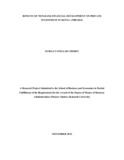| dc.description.abstract | Over the past five years, development in Non-Bank Financial Institutions (NBFIs) has assumed high preposition in Kenya. The trend could be attributed to: their renewed provision of products and services that banks either cannot or may not offer, also their potential to deliver other savings, investments and risk management tools. However, a number of empirical studies paid attention to the commercial banks development on economic growth and minimal studies had been carried out on the effects of NBFIs on private investment in Kenya. This study therefore sought to explore the effects of NBFIs development on private investment in Kenya. Using econometric techniques on dataset for Kenya over the period 1980-2014, Philip-Peron test was used to check for unit root, and the results showed that economic growth, public investment and inflation were stationary while NBFIs credit was non-stationary at levels; first difference was conducted to make it stationary. Heteroscedasticity was corrected using Robust Standard Error. Variable Inflation Factor of 1.14 indicated that there was no multi-collinearity. The value of Durbin-Watson statistic was 1.90452 which showed that there was no autocorrelation since the value was close to 2. The empirical results showed that NBFIs credit had a positive sign which is statistically significant at 10 percent. It shows that a 1 percent increase in credit leads to 0.018525 percent increase in private investment. Economic growth had a positive sign, and statistically significant at 5 percent, the results showed that when economic growth increase by 1 percent then private investment increases by 0.0082634 percent. Inflation had a positive sign, and statistically significant at 10 percent, the results indicated that a 1 percent increase in inflation, leads to 0.119548 percent increase in private investment. On the other hand, public investment had negative impact on private investment; the results show that when public investment increase by 1 percent, similarly private investment decrease by 0.4595379 percent. The research findings showed that higher amount of NBFIs credit, rising economic growth, higher inflation rates and low levels of total expenditure on public investment would boost private investment in Kenya. This study therefore recommended the use of efficient and modern technologies in the manufacturing and agricultural sector to increase private investment in Kenya, more NBFIs credit to the private sector and last but not least to reduce the government expenditure on public investment in order to avoid crowding out effect, was suggested to boost private investment in Kenya. The study is influential to the policy makers since the findings suggested areas that would enable the country to increase private investment, and ultimately the economic growth of the country would be felt. Also the study is beneficial to the future scholars since further studies have been recommended as per the findings. Future studies should corporate other non-quantifiable variables such as insecurity that would affect private investment in the country. | en_US |

